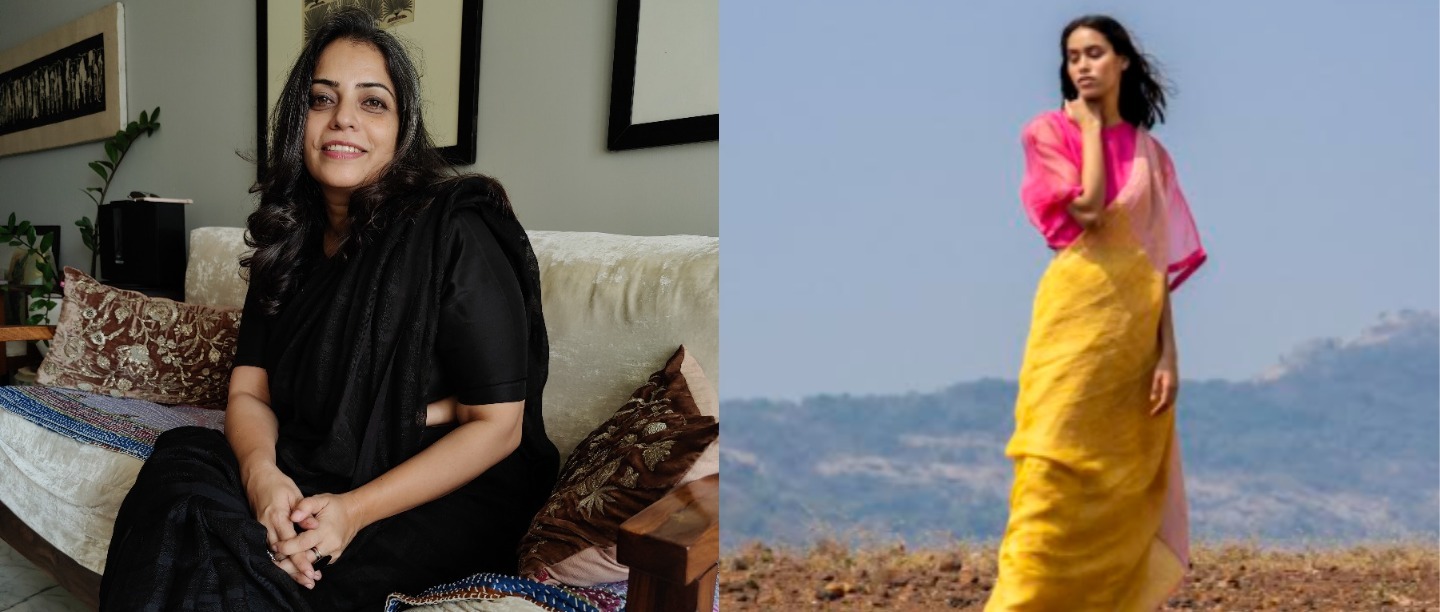
If you were asked to name the most quintessential Indian attire, what is the first outfit that would come to mind? For us, it will always be a saree, the six-yard wonder that has songs and poems written after its beauty. Of course, there’s a lot more to saree’s story including a full-fledged political history, the roots of which can be traced back to Mahatma Gandhi’s Swadeshi movement. The image that pops into mind is the humble khadi saree, an emblem of both independence and the Indian identity. But that’s just one facet of the saree. We also have opulent silks–the rich Kanchipuram and Banarasis. The list goes on. The gorgeous garment comes with various backstories and iterations, each one as beautiful as the other.
Now here’s a question: how do you infuse something so Indian with a global appeal? Designer Anavila Mishra sure knows the trick–the answer lies in her linen sarees. With her label, she is constantly re-inventing the linen fabric in India. In a recent interaction with POPxo, Anavila talked about the timeless allure of the saree and how she found her brand language in West Bengal’s handwoven linen.
Discovering The True Potential Of Linen
Anavila first explored her love for handloom through the CRAFT CLUSTER project that she undertook in 2004 for NIFT in association with the Ministry of Rural Development. It took her to various rural craft clusters across the country. The project paved the way for her eponymous brand by making her realise the potential of innovation in Indian textiles.
“Three years of focussed work and travel across villages and rural clusters not only gave me an in-depth knowledge on handlooms but also helped me garner deep bonds with the artisans I met through these travels,” shares Anavila. The CRAFT CLUSTER project also led her to West Bengal’s Phulia, a weaving centre that revealed to her the true potential of linen.
The Saree Update
As Anavila shares, her signature linen saree is a result of her close connection with nature. She started exploring the yarn after realising that it could bring a brilliant texture and comfort to the saree. From then the goal was to give saree a global, contemporary, and youthful appeal. In many ways, she has been able to achieve the same.
“When I was creating ideas to develop sarees, I came across linen as an ideal option in creating comfortable and contemporary silhouettes and yet giving it a luxurious touch. I have been working closely with several weavers from Jharkhand and West Bengal and I am in awe of their immense skill set and their fine craftsmanship. We always strive to keep working and innovating on these traditional weaves and textiles,” shares Anavila.
With her artisan partners, Anavila has been working on many interesting textures and designs on linen. Thanks to Ananvila, linen, which was an alien yarn to the saree sector has become a prized possession in every saree wearer’s wardrobe.
The Need For Designer-Artisan Collaborations
Anavila has worked on various product development projects with handloom artisans over the years and emphasizes the need for designer artisan collaborations. “These collaborations can help us change the landscape of Indian crafts,” she adds. Her work on linen is mostly connected with the artisans based out of West Bengal. The first linen saree designed by her was woven by a master weaver in the Phulia region in 2011. Since then, the brand has been working with artisans from the same region. From one household and loom to 200 looms and households, the brand has managed to create a sustainable livelihood for these artisans. The block printing cluster of Ajrakpur, Bhuj, the Khatwa artisans of Jharkhand, and block printers of Baroda are also an inseparable part of Anavila’s journey and brand aesthetic.
The Future Looks Good
Anavila sees a very positive and promising future for handlooms in India. She feels that there is a renewed interest and eagerness among the young Indians to understand our rich heritage. “I see more and more young designers and entrepreneurs choosing to work in the craft sector, this is changing the dynamics of the handloom industry and we will soon see the positive results of this,” she concludes.
To celebrate the ethereal beauty and the undeniable allure of Indian handicrafts, we are observing a handloom week this August through a series, titled Seven Days of Handloom. The series aims to introduce designers and brands who are working to preserve and reinvent the Indian handlooms. Click here to read about Handloom Rugs, Chanderi, Maharashtrian Handloom, Kanchipuram, and Banarasi.
Featured Image Courtesy: Anavila Mishra
Read More From Fashion
Wedding Outfit Ideas From Our Fave Bloggers To Be The Best-Dressed This Shaadi Season!
Isha Jain
Stylish Aakruti Sejpal Just Made Mirror Veils The Coolest Bridal Trend Ever!
Isha Jain